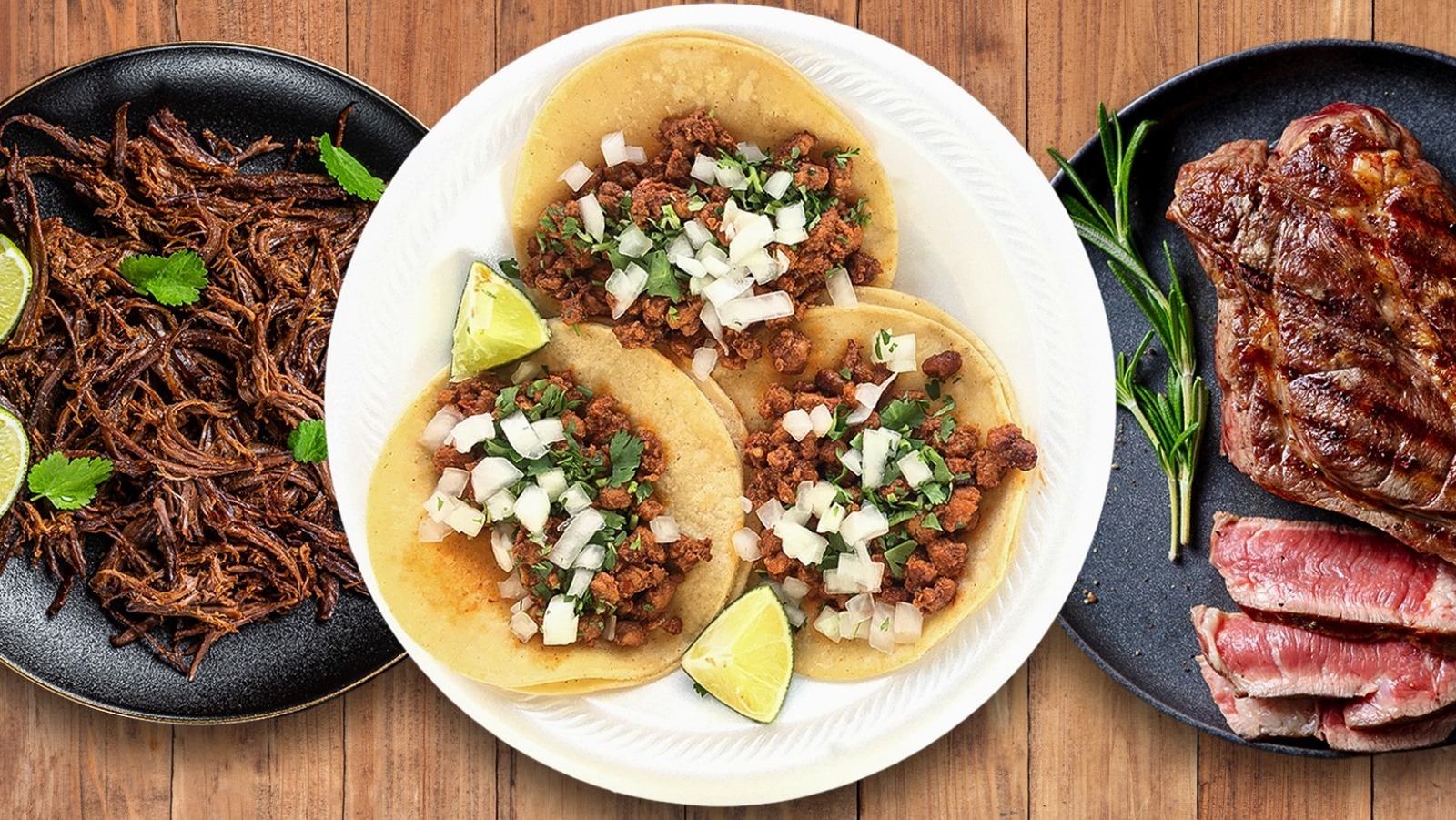The humble taco offers an endless array of options for fillings, but if you’re grabbing some from your local stand, you’ve probably got your eye on the three big classics of carne asada, barbacoa, and al pastor. As tacos have moved out of Mexico and gradually taken over not just America, but a lot of the world, the list of different types of tacos have expanded and expanded to the point where you can find them filled with jackfruit or Korean barbecue.
But tacos were born in Mexico, and it’s impossible to deny the perfect fusion of a freshly pressed tortilla and grilled or stewed Mexican meats. And even within the world of classic taco meats, carne asada, barbacoa, and al pastor show the incredible diversity you have to choose from. First off, each one of these options actually contains a whole lot of variety within them. In Mexico, barbacoa and al pastor are each styles of cooking rather than one specific dish.
But if you are getting them in America, they usually refer to one type of meat cooked that way: beef for barbacoa, and pork for al pastor. Carne asada also just means “grilled meat” in English, but in this case is almost always referring specifically to grilled steak. While each of these taco meats is pretty different in preparation and they have some unique flavors, each type shows off the diversity of both local and immigrant influences in Mexican cuisine.
What is carne asada?
For anyone whose knowledge of tacos has progressed beyond the ground beef facsimile of American childhoods, carne asada is probably one of the first taco meats they were introduced to. Carne asada is a class of simple grilled meats that exist in many Latin American countries, but the one most associated with tacos is the beef carne asada of Mexico. This version originated in the cattle-ranching country of northern Mexico.
Carne asada recipes can be made from different cuts of steak or beef, which are marinated and then grilled. While it’s a popular taco filling, carne asada is also eaten on its own as a dish with sides like beans and rice. The most common cuts of steak used for carne asada are thinner, leaner, and more affordable ones such as skirt steak and flank steak. Marinating carne asada overnight helps keep these leaner cuts juicy and tender, and then the steaks are quickly grilled over high heat to char them on the outside while keeping the meat from drying out.
A marinade recipe will vary by person and region, but they frequently have citrus such as lime juice or orange juice as a base, which lends the steak a bright, vibrant flavor. Beyond that, other common Mexican flavors like cumin, chiles, garlic, and oregano are used. The best carne asada has a complex flavor that marries the meatiness of the steak with a smoky flavor from the grill and the fresh tastes of the marinade.
What is barbacoa?
Barbacoa refers to a larger style of cooking in Mexico that involves slow-cooking tougher cuts of meat as a stew or braise. The name barbacoa means “barbecue” in Spanish, but it’s not what most Americans would consider barbecue-style cooking. While now widespread in Mexico, barbacoa actually originated with native people in the Caribbean before it spread through the Latin American world.
The original version involves slow-cooking meats over an open fire, but in Mexico it evolved into cooking meat wrapped in agave leaves in pits dug in the ground. This has more of a steaming effect to it. While barbacoa is still sometimes prepared this way, modern versions have been adapted for indoor kitchens and are more similar to a braised roast. Lamb or goat can be made into barbacoa, but for most taco spots in America, the meat is beef. It’s best made with fatty but tough cuts like beef chuck or brisket.
The meat is usually cooked in a braising liquid that is heavily seasoned with chiles, vinegar, herbs, and citrus, and sometimes more unique spices like cloves and aromatic vegetables. Once the slow-cooked meat is tender, it is shredded, and the reduced braising liquid is spooned back on top as a sauce. Because the sauce itself is so flavorful, it doesn’t normally need salsa, and a classic taco topping of onions and cilantro is the standard. But you may also see other bright toppings, such as pickled vegetables, that balance out the rich, saucy meat.
What is al pastor?
Despite its ubiquity as a taco meat, al pastor is actually a relatively recent creation. Al pastor tacos involve meat, almost always pork, that is cooked on a spit and sliced as it chars. This is very similar to the way Middle Eastern shawarma is cooked, because al pastor actually evolved from Lebanese immigrants to Mexico in the early 20th century. They cooked spit-roasted meats tailored to the local tastes of the Mexican population they were serving, and al pastor, meaning “shepherd-style,” became the name because the Lebanese in Mexico were associated with herding.
These immigrants adapted the recipe over the years, and the current chili-marinated pork version that is the best known style of al pastor appeared in Mexico City in the 1960s. Al pastor can be made with beef or lamb, but pork shoulder is the most popular. The marinade for al pastor is usually chile based, and typically also features the earthy spice achiote, which gives al pastor its signature red color.
Thin slices of marinated pork are stacked on the rotating spit, called a trompo, and topped with pineapple. As the pork is cooked, the fat and pineapple juice drips over the meat, flavoring it and helping it crisp up. The pork is sliced off once charred and piled into the tortilla with salsa, onion, cilantro, and often roasted pineapple. It’s sweet, smoky, earthy, fiery, rich, and bright all at once. A true culinary collision of worlds. Of course, for convenience, you can also make al pastor in a slow cooker.








